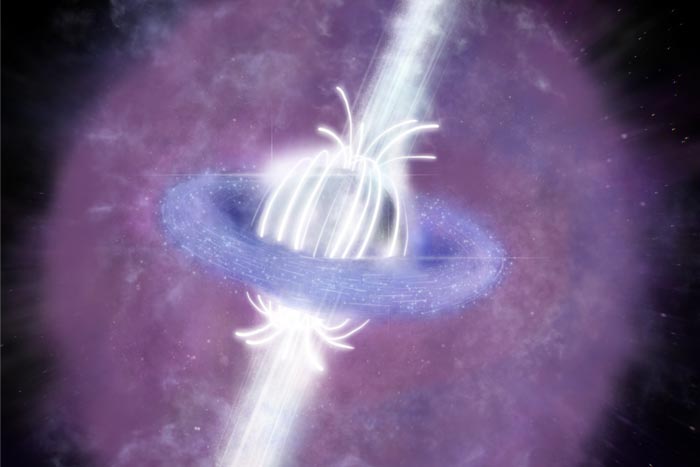Deep-space discovery

Artist rendering.
Image credit: Anyu Lei and Jing Chen, Nanjing University School of Arts
Oddball gamma-ray burst forces revision of theoretical framework.
A long-duration gamma-ray burst observed in late 2021 revealed signatures typically associated with short-duration bursts, forcing puzzled scientists to create a new model for the origin of this unique burst.
The mysteries of the cosmos continue to amaze astronomers, and with each new observation comes a chance to deepen – or upend – our understanding of the universe.
In the Dec. 7 issue of the journal Nature, an international team of astrophysicists report the discovery of a unique cosmological gamma-ray burst (GRB) that defies prevailing theories of how the violent cosmic explosions form. This “oddball” burst led the team to propose a new model, or source, for certain types of GRBs.
Gamma-ray bursts are the most luminous and violent explosions in the universe. They signify the deaths of stars or collisions of stellar remnants. Observed GRBs are typically placed into two categories: short- or long-duration GRBs. Long GRBs originate from the deaths of massive stars, and are typically associated with bright optical transients named supernovae. Short GRBs have a duration of less than two seconds and originate from the collisions of two neutron stars or a neutron star and a black hole, and are typically associated with more faint optical transients known as kilonovae.
For decades, GRBs nestled nicely into these cozy categories. Until now.
On Dec.11, 2021, a GRB triggered several gamma-ray detectors in space, including NASA’s Fermi Gamma-ray Telescope and the Neil Gehrels Swift Observatory. This burst, with a duration of nearly 70 seconds, would typically be regarded as a normal long GRB. That is, until multiple teams from the U.S. and Europe performed follow-up observations and discovered a surprising signature.
“This GRB includes two parts: a 13-second long hard spike and a 55-second softer extended emission,” said UNLV alumnus and study corresponding author Bin-Bin Zhang, who’s currently with China’s Nanjing University. “The duration of the 13-second hard spike should have completely excluded this burst from the short GRB category.”
In other words, instead of showing a much brighter supernova, as expected, the observation was consistent with a kilonova that is more typically associated with a short GRB.
“Such a peculiar GRB was the first of its kind ever detected,” said UNLV astrophysics professor Bing Zhang, co-corresponding-author of the Nature paper. “This discovery not only challenged our understanding of GRB origins, it also requires us to consider a new model for how some GRBs form.”
The research team believes that this unique GRB, known as GRB 211211A, likely formed through collision between a neutron star and a white dwarf, what’s known as a WD-NS merger.
White dwarfs are earth-sized objects that form from the death of low-mass stars – those with a mass smaller than that of about eight of our Suns. Neutron stars form when more massive stars, those with a mass of between about eight and 20 Suns, die off. When even larger stars die, they form black holes directly.
Massive, low-density stars make long-duration GRBs whereas high-density stars, including neutron stars, make short duration GRBs. According to UNLV’s Zhang, white dwarfs have intermediate densities, which make them ideal origins for the type of GRB discovered in 2021 as it displays an intermediately long duration without involving a massive star.
“Despite the relatively large number of GRBs observed each year, the unique signature of GRB 211211A pushed the envelope of our current categorial systems and required a new way of thinking,” said Zhang. “After careful review, the only merger scenario that made sense was that of a white dwarf and neutron star.”
UNLV doctoral student Shunke Ai and a student from Nanjing University collaborated to develop a detailed model to interpret the peculiar kilonova signature observed by GRB 211211A. Ai found that if a WD-NS merger leaves behind a rapidly spinning neutron star, known as a magnetar, the additional energy injection from the magnetar combined with the nuclear reaction energy from the material thrown during the burst can account for the kilonova emission observed for GRB 211211A.
About the Study
The study, “A long-duration gamma-ray burst with a peculiar origin”, appeared Dec. 7 in the journal Nature. The paper includes 10 co-authors from 4 institutions, with UNLV and Nanjing University being the lead institutions. Published in the same issue are three parallel papers that report the detection of the kilonova. This paper focuses on the peculiar gamma-ray emission itself and proposes the WD-NS merger model to interpret the data.
Journal: Nature
DOI: 10.1038/s41586-022-05403-8
Method of Research: Observational study
Subject of Research: Not applicable
Article Title: A long-duration gamma-ray burst with a peculiar origin.
Article Publication Date: 7-Dec-2022
COI Statement: The authors declare no competing interests.
Media Contact
Tony Allen
University of Nevada, Las Vegas
tony.allen@unlv.edu
Office: 702-895-0893
Original Source
All latest news from the category: Physics and Astronomy
This area deals with the fundamental laws and building blocks of nature and how they interact, the properties and the behavior of matter, and research into space and time and their structures.
innovations-report provides in-depth reports and articles on subjects such as astrophysics, laser technologies, nuclear, quantum, particle and solid-state physics, nanotechnologies, planetary research and findings (Mars, Venus) and developments related to the Hubble Telescope.
Newest articles

Future AR/VR controllers could be the palm of your hand
Carnegie Mellon University’s EgoTouch creates simple interfaces for virtual and augmented reality. The new generation of augmented and virtual reality controllers may not just fit in the palm of your…

‘Game changer’ in lithium extraction
Rice researchers develop novel electrochemical reactor. A team of Rice University researchers led by Lisa Biswal and Haotian Wang has developed an innovative electrochemical reactor to extract lithium from natural…

The blue-green sustainable proteins of seaweed
… may soon be on your plate. The protein in sea lettuce, a type of seaweed, is a promising complement to both meat and other current alternative protein sources. Seaweed…



